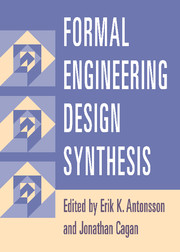Book contents
- Frontmatter
- Contents
- Contributing Authors
- Foreword
- Preface
- Introduction
- 1 Vitruvius Redux
- 2 How to Calculate with Shapes
- 3 Engineering Shape Grammars
- 4 Creating Structural Configurations
- 5 Microsystem Design Synthesis
- 6 Function-Based Synthesis Methods in Engineering Design
- 7 Artificial Intelligence for Design
- 8 Evolutionary and Adaptive Synthesis Methods
- 9 Kinematic Synthesis
- 10 Systematic Chemical Process Synthesis
- 11 Synthesis of Analog and Mixed-Signal Integrated Electronic Circuits
- 12 Mechanical Design Compilers
- 13 Scientific Discovery and Inventive Engineering Design
- Index
6 - Function-Based Synthesis Methods in Engineering Design
State of the Art, Methods Analysis, and Visions for the Future
Published online by Cambridge University Press: 10 October 2009
- Frontmatter
- Contents
- Contributing Authors
- Foreword
- Preface
- Introduction
- 1 Vitruvius Redux
- 2 How to Calculate with Shapes
- 3 Engineering Shape Grammars
- 4 Creating Structural Configurations
- 5 Microsystem Design Synthesis
- 6 Function-Based Synthesis Methods in Engineering Design
- 7 Artificial Intelligence for Design
- 8 Evolutionary and Adaptive Synthesis Methods
- 9 Kinematic Synthesis
- 10 Systematic Chemical Process Synthesis
- 11 Synthesis of Analog and Mixed-Signal Integrated Electronic Circuits
- 12 Mechanical Design Compilers
- 13 Scientific Discovery and Inventive Engineering Design
- Index
Summary
OVERTURE: BACKGROUND, INTRODUCTION, AND MOTIVATION
MOTIVATION
The activity of concept generation is one of the lampposts of engineering design. It provides a forum for designers to apply creativity and contribute their personal flair. It also represents the time when technology is chosen or developed to fulfill the customer's needs.
The imaginary clay of product development is molded during concept generation. Until recently, the tools to shape this clay relied, almost entirely, on the experience and innate abilities of the designer or design team. Concept generation, fundamentally, was considered art, not science; informal, not formal.
In the past two to three decades, our tool set has changed significantly. Methods are continuously being developed, tested, implemented in industry, and taught to our engineering community (Otto and Wood, 2001). Figure 6.1 shows a simplistic view of these methods, where customer needs are first transformed to a repeatable functional representation, then to layouts and solution pieces, then to broad combinations and alternative products, and finally to an embodied realization that we can produce for the customer. With the use of these methods, our resulting abilities to develop products, and their underlying architectures, are significantly enhanced.
But is this developing tool set complete and convergent? New methods over the past decade (or less) resoundingly indicate a “no” to this question. Formal methods in engineering synthesis, although in their infancy, are emerging as new and complimentary possibilities for shaping the clay of product concepts.
- Type
- Chapter
- Information
- Formal Engineering Design Synthesis , pp. 170 - 227Publisher: Cambridge University PressPrint publication year: 2001
- 13
- Cited by



